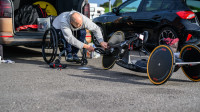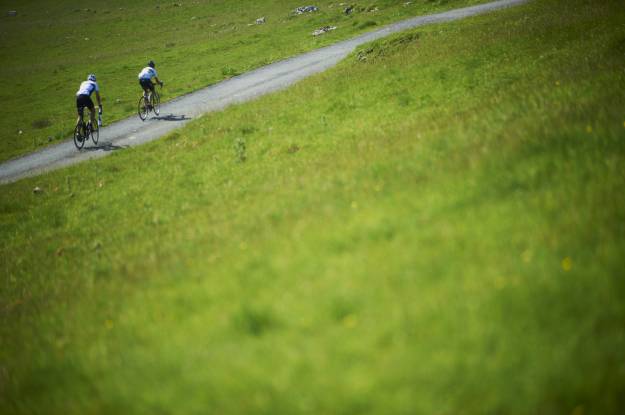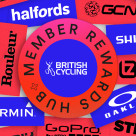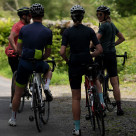Knowledge Level: Beginner
For full on 45-60 minute hard workouts, guaranteed improved bike handling skills and motivational muddy racing fun through the winter, cyclo-cross is unbeatable. It’s an incredibly accessible form of cycle sport, with many events having on the day entry and allowing you to give it a go on a mountain bike. You’ll have fun on a mountain bike but, to really get the most out of cross, a specialist bike is well worth considering
Frame Geometry
The geometry of a pure racing cyclo-cross bike is fairly similar to a road bike and is designed to be fast, nimble and responsive around the twisting courses. The forks and stays are designed to give plenty of clearance for wider tyres and mud though. Compact geometry frames with sloping top tubes are not usually found on cross bikes as room is needed for shouldering the bike. Bottom bracket heights are also slightly higher to give more clearance over rough ground.
Gravel/Adventure differ from pure cyclo-cross bikes in that they tend to have a more relaxed geometry, reflecting their intended use for long days in the saddle exploring by-ways and bridleways. You can also expect to find drillings for panniers and mudguards on these type of bikes which, won’t be present on a dedicated cyclo-cross racer. However, you could certainly take part in and enjoy cyclo-cross on a gravel/adventure bike and, with road tyres fitted, also makes a great option for commuting and winter training.
Brakes
Traditionally cyclo-cross bikes have been fitted with cantilever brakes but disc brakes are now becoming the standard. Braking is far more powerful and easy to modulate, rim wear is no longer an issue and, with the braking surface farther from the mud, braking performance remains reliable and consistent throughout the race. Some riders also choose to fit additional bar-top brake levers which can offer a more stable riding position on technical terrain.
Gearing
The classic cyclo-cross gearing is a 42/36t double chainring with a 12-27t cassette. This isn't a lot lower than you would typically find on a road bike and definitely not the super low “granny gears” you would associate with mountain biking. Rather than spinning up the short steep climbs typically found on cross courses, riders will shoulder their bikes and run, meaning you don’t need mountain bike gearing. With heavy mud often jamming front derailleurs, many riders now opt for the simplicity of a single chainring setup. Depending on the course and strength of rider, chainring size will range typically between 40-44t and, with dedicated wide/narrow chainrings and clutch rear mechs now avaialble, chain retention devices are unnecessary. Some riders also opt for the ultimate simplicity of a single-speed set-up and many races dedicate a class to them.
Wheels
Wheels for cyclo-cross primarily need to be tough, so traditional box-section alloy rims with 32 spokes are common. If you’re running disc brakes, you’ll need a disc specific hub to accommodate the rotor. You will see some riders using deep section carbon wheels as, despite aerodynamics not being a priority, they cut through deep mud, sand and snow better than shallower section rims. Crashing with this type of wheels could be an expensive business though and, as spills are very common in cyclo-cross, you are probably better off leaving your expensive deep section wheels on your road or TT bike.
Tyres
Get a group of cyclo-cross riders together and you can guarantee that the conversation will soon turn to talk of tyre brands, tread patterns and tyre pressure. Cyclo-cross tyres are typically 28-35 mm wide, compared to the 23-28 mm width of road tyres. For UCI sanctioned events the maximum width allowed is 33 mm. However, at your local cross race, you can certainly go wider than this. The tread on cyclo-cross tyres varies from almost smooth file tread for hard and dry conditions to full “knobblies” with almost every variant in-between. Top racers will agonise about tyre choice and have multiple sets of wheels with different tubs glued on. However, for less serious riders, there are many sensible all-rounder tyres that will cover most eventualities and, if you are racing in the UK, you can usually assume it will be on the muddy side.
Tubular tyres are still favoured in cyclo-cross, as they allow you to run super low pressures without the risk of pinch flats. However clinchers are cheaper and easier to repair or replace and offer more flexibility. Tubeless setups are becoming popular as they give many of the advantages of tubulars in combination with the convenience and affordability of clinchers. On extremely muddy courses, riders using tubulars will run pressures as low as 20 psi in the search for grip but, if you are on clinchers, 30-40 psi is more typical.
Cable Routing
Cables on a cross bike are either internally routed or fitted along the top of the top-tube. This keeps them out of the mud and out of the way when shouldering the bike.
Pedals
Clipless mountain bike style pedals with double, or even four sided, entry are usual for cyclo-cross. These allow easy clipping in and out for the multiple mounts and dismounts, clear themselves of mud and, with recessed cleats on the shoes, are comfortable to run in.
Bike number two
At the upper levels of the sport, riders will have a matching pair of bikes and a pit crew. While the rider is on one bike, the crew will be cleaning the other ready for a quick swap. In really foul conditions, an experienced pit crew and slick well timed bike changes can make the difference between winning and losing. However, for most regional level events, there will be plenty of riders racing with just one bike.











